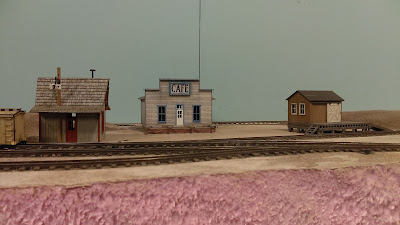This little freight house kit is from AM Models and was only about $10 on ebay. I really like the design of the dock and the very small footprint it occupies; perfect for the available space. Plus, it's in perfect character for the MVRR's look.
While I generally like to scratchbuild things, I must say that building something in kit form was a very relaxing diversion. It allows me to quickly get down to business with painting, weathering, and detailing, my favorite part.
This is my first time trying out some oil wash techniques for weathering, and I'm very happy with the result. The wash consists of lamp black, burnt sienna, and odorless thinner; it flows very naturally and finds the perfect crevices and corners to collect in.
Tonight, I put the doors and windows on. I'll be adding "glass" soon, and trying out a new technique to simulate dirty windows.
You can see the roof in the background; I'll be applying strips of 1200 grit sandpaper to simulate tarpaper roofing. I'm putting that task off until later.
Here's a trackside view of the town as it stands today.
And, an aerial view.
Here's my general plan moving forward; definitely some changes and tweaks to the original design. I have two more "scenes" I want to develop in town that I haven't decided on. I've decided to install a low backdrop to hide the rear track. The grade crossing will also be moved to the foreground between the depot and the freight house.
On the other side of the layout, the mountain will grow a bit taller than it was before, with a full-blown tunnel boring through the curve. I scratchbuilt a timber tunnel portal to feature here.
So that's what's in store. There are a lot of projects to do, and I'm actually enjoying the scattershot approach to tackling each one as the mood suits me. It's nice to get back into the workshop, even for just a couple hours each week.






































